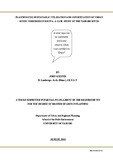| dc.description.abstract | This study focuses on planning for sustainable utilization and conservation of urban river corridors in Kenya, a case
study of Nairobi River. The study was borne out of the need to protect Nairobi River corridor from prolonged degradation
through pollution of various kinds, which have impacted negatively on the ecosystem of urban riverine environment as
well as socio-economic development of the urban inhabitants including their rural counter parts downstream.
The study was carried out as a case study and focused on Nairobi River Corridor specifically on the section of the river
corridor defined by Pumwani Road and Lamu Road; located in Nairobi city, the capital city of Kenya. The river was
purposively sampled because of its historical significance in the establishment and the development of Nairobi City with
the city deriving its name from this river. The study investigated the main challenges hindering sustainable utilization and
conservation of the Nairobi River Corridor, examined the type of river degradation occurring in the study area, and the
main causes of the observed river degradation. It further sought to identify the policy, legislative and institutional
measures in place and the gaps for sustainable utilization and conservation of the said river corridor besides assessing
the available Political, Economic, Social, Technological, Environmental and Legal (P.E.S.T.E.L) options for its
sustainable utilization and conservation.
Two groups of respondents comprising of direct users of the river corridor (informal group) - with a population of about
650 persons and indirect users of the river corridor (formal group) - with a population of about 545 persons, were
engaged in the study. Stratified and systematic sampling methods were employed to obtain a sample size of fifty six (56)
and fifty four (54) respondents for informal and formal groups respectively. Key government ministries and departments
totaling ten (10) were also purposively selected and involved in the study. Primary data was collected through structured
questionnaires, personal interviews, field observations and photography; while secondary data was obtained by
reviewing of pertinent literature materials. Results of data analysis were presented using frequency distribution tables,
bar charts/graphs and pie charts.
The study established that the river corridor has been left out as a common pool resource which is exploited by anyone
who asserts his or her rights to do so. Consequently, it has lost its utility value and is not used for the city’s appropriate
needs despite its potential to do so. Its waters for instance, cannot be used for commercial, agricultural, domestic,
industrial, amenity or recreation purposes. In view of this, the study recommends adoption of enhanced pollution control
mechanisms such as proper garbage/waste collection and management, surveillance of the river corridor and relocation
of the existing water-polluting socio-economic activities away from the river channel. The study further recommends
adoption of appropriate planning interventions such as replanting of the riparian reserve with river-based plant materials,
clear zoning/ demarcation of the riparian reserve and orientation of existing and new buildings towards the river corridor
to reduce its risks of encroachment and illegal dumping of waste since this will promote surveillance of the river corridor.
It further calls for promotion of public awareness and involvement of the users in the entire conservation scheme. To this
end, this study has been designed to evolve conservation lessons that are widely expected to apply in other river
corridors that fall within the same bracket of degradation. | en_US |

